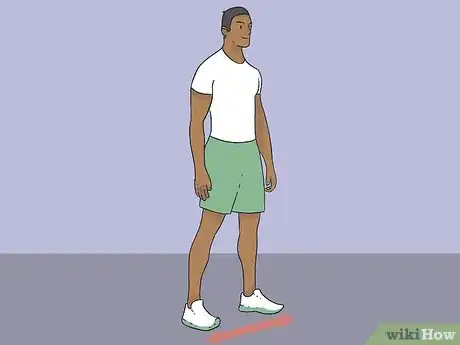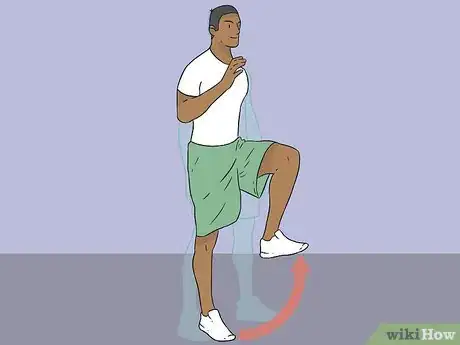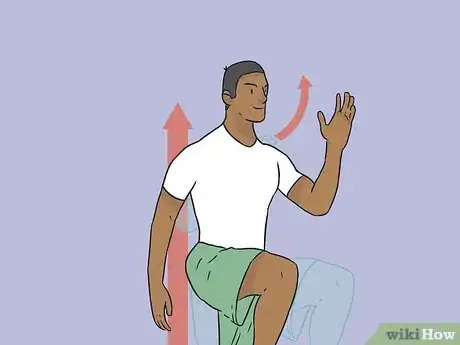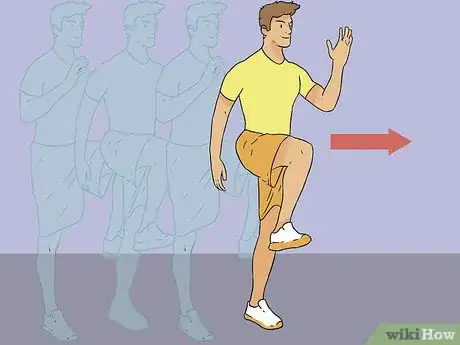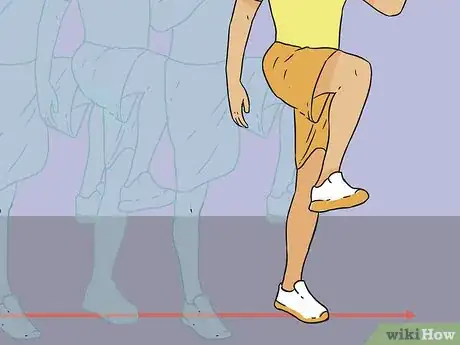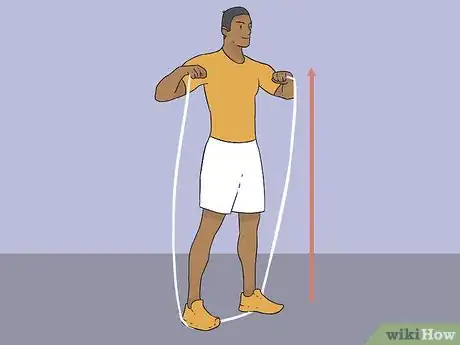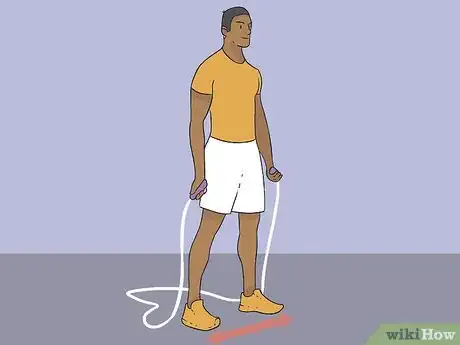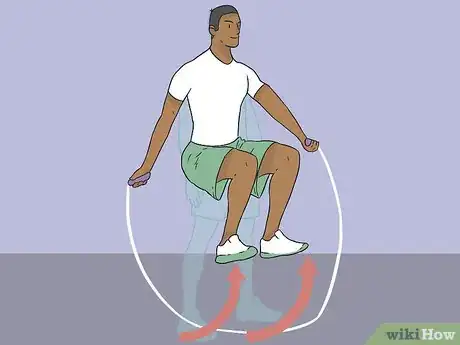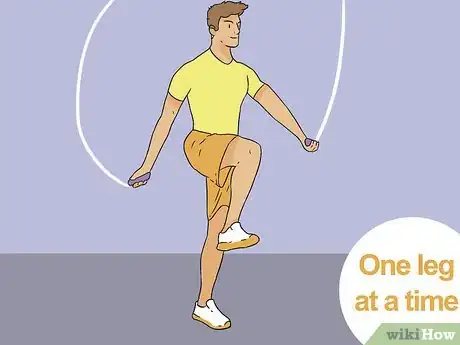This article was co-authored by Steve Bergeron. Steve Bergeron is a Personal Trainer, Strength Coach, and the Co-Owner of AMP Fitness in Boston, Massachusetts. With over a decade of experience, Steve specializes in educating, guiding, and empowering his clients to develop healthy habits and reach their individual fitness goals. He holds a BS in Exercise Physiology and is an NSCA Certified Strength and Conditioning Coach (CSCS), ASCM Health and Fitness Specialist (HFS), Strong First Kettlebell Coach (SFG), and Certified Functional Movement Screen Specialist (FMS). AMP Fitness’ mission is to create a community that is inclusive and gives people the tools and support they need to succeed.
This article has been viewed 31,131 times.
A great way to stay in shape, high knees can be integrated into your workout routine as either a warm-up or cool down, or used as a main exercise for various core and leg muscles. They can be performed comfortably by most healthy people and are easy to moderate in difficulty level. Because you can perform them both indoors and outside, high knees are an ideal method to help improve flexibility, endurance, and extend running pace. They also help to simultaneously strengthen hip muscles to add physical stability. If you have knee, hip, back, or foot problems, check with your healthcare provider before doing high knees.
Steps
Performing a Stationary High Knee
-
1Keep your arms at your sides, feet hip-width apart. Stand tall with your thighs perpendicular to the ground as you begin this motion, making sure not to move them higher than this parallel point. Avoid kicking your legs backward while doing this.
-
2Slowly lift one knee at a time. Alternate between each of your knees one at a time, lifting and lowering your legs at the same steady speed. Lift your left knee as high as you can and then lower at the same speed, letting your foot touch the ground right before lifting your right knee up to repeat this same process.
- Take off and land on the balls of your feet.
- If you're using good form, your feet will be lined up directly below your knees. Your feet should not be extended out or bent back.
- High knees consist of lifting your knees as high up as possible, your left and right knees raising and lowering in an alternating fashion.
Advertisement -
3Begin swinging your arms while maintaining a slow march. Swing your arms from your shoulders front and back while avoiding side-to-side swaying. You should synchronize this movement with the opposite leg. Keep your elbows bent, with hands passing your body near the hips.
-
4Pick up your pace, lifting your knees quickly while maintaining good form. Keep your eyes focused straight ahead while keeping your back straight to sustain stable posture.[1] Your legs should still be lifting and lowering in an alternating fashion. As your pace quickens with your gained confidence, your hands should rise up level to your cheeks with each knee up.[2]
-
5Do double high knees only when you're ready. You can perform double high knees by jumping, bringing both knees up towards your waist. You can hold your hands at your waist, slapping your knees against them when you jump, or you can swing your arms.
- You should only progress to this stage if you have healthy knees and ankles.
- At first, you may want to jump just a few inches off the ground, working your way up to double high knees.
- If you're an advanced athlete, you can mix double high knees with other high-intensity intervals for a more complete workout.
Executing Walking High Knees
-
1Begin by performing stationary high knees. Do a couple repetitions of this to get comfortable with the motion and formation prior to beginning any forward movement. Start by lifting your left leg as high as you can and then lower at the same speed before lifting your right leg and doing the same. You should be taking off and landing on the balls of your feet.
- While doing high knees, be sure your back is straight, arms are swaying, and eyes are focused straight ahead.
- Lift your left and rights knees as high as possible in an alternating fashion for the duration of your high knee exercise. Knees should be raised and lowered at the same speed, starting off slowly and gaining speed as your comfort in performing the exercise increases.
-
2Step forward slowly to start moving at a walking pace. Once you have mastered doing the standard stationary high knee, you can begin moving forward. During each knee high, lower your leg a few inches away from its original take off point. Pay attention to lifting your knees up and bringing them down rapidly, rather than physically moving forward at a swift speed.
- Slow your movements down if your form begins to suffer.
-
3Pick up your speed while moving in a straight line. Gradually pick up the pace of your high knees while you move forward, as you get comfortable with the motion. Keep your arms following the natural movement that they would if you were running.[3]
- Focus on achieving a high turnover of performing many high knees rather than racing down the hallway. Be patient and focus your attention on single areas of improvement at a given time, rather than many all at once.
Jumping Rope with High Knees
-
1Select a jump rope that is the appropriate length. To do this, hold onto each of the rope's handles and step on the center of it with your feet pressed together side-by-side. The rope is the correct length for your height if it can be comfortably lifted by the handles up to your armpits. It should not exceed this length.[4]
-
2Get into position to begin high knees while jumping rope. Ensure that you can safely begin performing the exercise and that you are not in a position that will cause you physical harm once the workout begins. Take the rope handles in each of your hands and place your feet in front of the jump rope, hip-width apart. Allow the rope to rest on the ground behind your heels.[5]
- Let your arms hang while tucking your elbows into your sides. Bring your hands up so that your forearms rest parallel to the ground, with your feet a couple inches apart. This will be your starting position.[6]
-
3Be prepared to jump in proper high knee form. Alternate between each of your knees one at a time, lifting and lowering your legs at the same steady speed. Take off and land on the balls of your feet. When doing high knees with a jump rope, lift both knees as high as possible, simultaneously.
- If you're just getting started, it's okay to start small and work your way up to high knees. At first, jump just a few inches off the ground. As you get better at jumping rope, jump higher, bringing your knees up. When you're ready, start doing high knees.
- Since this exercise is very intense, you should only do it 2 to 3 times per week.
-
4Swing the rope over your head and jump off the ground with both feet. Repeat this motion for the duration of your high knee workout. As the rope begins to reach your feet, jump over it while raising both knees as high as possible.[7] Only flick your wrists and forearms when bringing the jump rope around, as opposed to swinging with the force of your entire arm.[8]
- Always start out the exercise slow and build up into a faster rhythm as you work into it. Your knees should be rising and lowering at the same speed, consistently increasing in speed as you gain confidence in the workout.
- Repeat these motions until the necessary time has elapsed, or total number of repetitions have been completed, as outlined by your workout regime.
-
5Perform a variation of the exercise to switch things up. Do the exercise with only one leg at a time. Switch from your left to right foot after the completion of each repetition, alternating between the two. This would consist of lifting each knee as high as possible, left to right, an alternating fashion.[9]
- You can also alternate from the left to right foot with each jump, within the same set.
Expert Q&A
-
QuestionHow high should my knees go?
 Steve BergeronSteve Bergeron is a Personal Trainer, Strength Coach, and the Co-Owner of AMP Fitness in Boston, Massachusetts. With over a decade of experience, Steve specializes in educating, guiding, and empowering his clients to develop healthy habits and reach their individual fitness goals. He holds a BS in Exercise Physiology and is an NSCA Certified Strength and Conditioning Coach (CSCS), ASCM Health and Fitness Specialist (HFS), Strong First Kettlebell Coach (SFG), and Certified Functional Movement Screen Specialist (FMS). AMP Fitness’ mission is to create a community that is inclusive and gives people the tools and support they need to succeed.
Steve BergeronSteve Bergeron is a Personal Trainer, Strength Coach, and the Co-Owner of AMP Fitness in Boston, Massachusetts. With over a decade of experience, Steve specializes in educating, guiding, and empowering his clients to develop healthy habits and reach their individual fitness goals. He holds a BS in Exercise Physiology and is an NSCA Certified Strength and Conditioning Coach (CSCS), ASCM Health and Fitness Specialist (HFS), Strong First Kettlebell Coach (SFG), and Certified Functional Movement Screen Specialist (FMS). AMP Fitness’ mission is to create a community that is inclusive and gives people the tools and support they need to succeed.
Personal Trainer & Strength Coach You actually don't want to bring your knees up as high as you can. If you do, you'll start to round your back, which isn't good. Instead, you want your knees to go up to about hip height or slightly higher.
You actually don't want to bring your knees up as high as you can. If you do, you'll start to round your back, which isn't good. Instead, you want your knees to go up to about hip height or slightly higher. -
QuestionWhat's the right position for the rest of my body as I'm lifting my knees?
 Steve BergeronSteve Bergeron is a Personal Trainer, Strength Coach, and the Co-Owner of AMP Fitness in Boston, Massachusetts. With over a decade of experience, Steve specializes in educating, guiding, and empowering his clients to develop healthy habits and reach their individual fitness goals. He holds a BS in Exercise Physiology and is an NSCA Certified Strength and Conditioning Coach (CSCS), ASCM Health and Fitness Specialist (HFS), Strong First Kettlebell Coach (SFG), and Certified Functional Movement Screen Specialist (FMS). AMP Fitness’ mission is to create a community that is inclusive and gives people the tools and support they need to succeed.
Steve BergeronSteve Bergeron is a Personal Trainer, Strength Coach, and the Co-Owner of AMP Fitness in Boston, Massachusetts. With over a decade of experience, Steve specializes in educating, guiding, and empowering his clients to develop healthy habits and reach their individual fitness goals. He holds a BS in Exercise Physiology and is an NSCA Certified Strength and Conditioning Coach (CSCS), ASCM Health and Fitness Specialist (HFS), Strong First Kettlebell Coach (SFG), and Certified Functional Movement Screen Specialist (FMS). AMP Fitness’ mission is to create a community that is inclusive and gives people the tools and support they need to succeed.
Personal Trainer & Strength Coach You want to try to keep your torso nice and tall and your abs engaged like someone is going to hit you in the stomach. That will help keep your spine in a neutral position.
You want to try to keep your torso nice and tall and your abs engaged like someone is going to hit you in the stomach. That will help keep your spine in a neutral position.
Warnings
- Always perform high knees while standing on a soft, flat surface, such as a rubber gym mat. Performing them on concrete or other hard surfaces can cause damage to the knees and joints.[12]⧼thumbs_response⧽
- Never push yourself too far in a workout, as it may cause your body more harm than good. High-intensity workouts that your body is unaccustomed to can result in stress fractures, stiff or sore joints and muscles, and inflamed tendons and ligaments.[13]⧼thumbs_response⧽
- Don't exercise too often, for too long. According to a Mayo Clinic Proceedings study, individuals who exercise 8 or more hours per week are much more likely to develop heart disease compared to people who work out more moderately.[14]⧼thumbs_response⧽
References
- ↑ https://www.healthination.com/fitness/how-to-do-high-knees
- ↑ https://www.healthination.com/fitness/how-to-do-high-knees
- ↑ http://traininghardcore.com/high-knee-exercise
- ↑ https://www.exercise.com/exercises/high-knees-jump-rope
- ↑ https://www.exercise.com/exercises/high-knees-jump-rope
- ↑ https://www.exercise.com/exercises/high-knees-jump-rope
- ↑ https://www.exercise.com/exercises/high-knees-jump-rope
- ↑ https://www.exercise.com/exercises/high-knees-jump-rope
- ↑ https://www.exercise.com/exercises/high-knees-jump-rope
- ↑ https://www.health.harvard.edu/healthbeat/10-tips-for-exercising-safely
- ↑ https://www.health.harvard.edu/healthbeat/10-tips-for-exercising-safely
- ↑ https://www.exercise.com/exercises/high-knees-jump-rope
- ↑ https://www.health.harvard.edu/healthbeat/10-tips-for-exercising-safely
- ↑ http://www.sacbee.com/news/nation-world/national/article179463911.html
